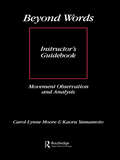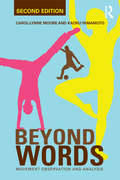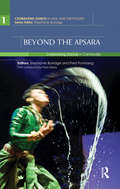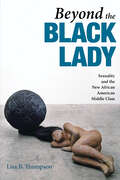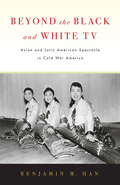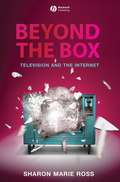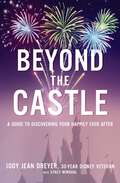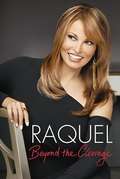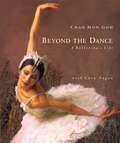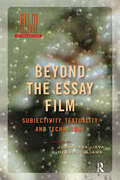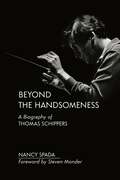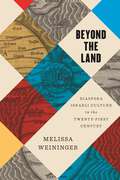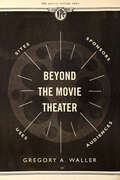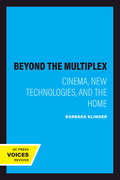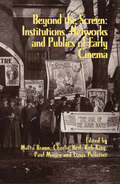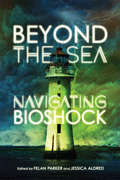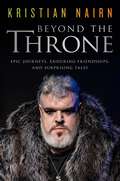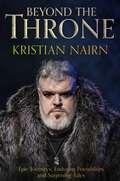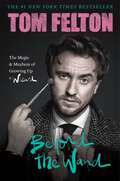- Table View
- List View
Beyond Uhura: Star Trek and Other Memories
by Nichelle NicholsAutobiography of the woman who played Uhura, the communications officer of the Starship Enterprise, on the original Star Trek series
Beyond Virtual Production: Integrating Production Technologies
by Barnett, Edited by Tully Jason Bevan Cameron Mackness Zoë WallinBeyond Virtual Production brings together a range of creative practice research projects that have been undertaken in The Void, an early-adopter university-based virtual production studio at Flinders University in South Australia.From a cross-disciplinary short virtual production film, to a VR simulation of the last 100 seconds of life of earth, to the live performance of the virtual band Big Sands, to augmented and extended reality, to archaeological projects, this collection captures the potential applications of virtual production technology and provides a framework for cross-disciplinary work and industry collaborations both in a university context and beyond. It offers insight into the development of virtual production courses and encompasses research into theories of performance, liveness, methods for co-creation, gender in virtual production careers, and object digitization and its representation while highlighting significant pathways of industry partnerships alongside experimental art practices.Creative technology and interdisciplinary practitioners, researchers, students, and teachers will find inspiration and practical guidance in these chapters.
Beyond Words: Instructor's Manual
by Carol-Lynne Moore Kaoru YamamotoThis guidebook is designed to facilitate the use of "Beyond Words" materials. By drawing on their own teaching experiences, the authors offer suggestions for attaining teaching/learning goals, and for overcoming difficulties in using the movement observation and analysis programme. Many of the creative adaptations described come from individuals at different institutions who tested "Beyond Words" while it was being developed. It is not intended, therefore, as a prescriptive document, but rather as a guide which provides many alternative ways of utilizing "Beyond Words", and which leaves the rest to the instructor.
Beyond Words: Movement Observation and Analysis
by Carol-Lynne Moore Kaoru YamamotoBeyond Words presents a range of illuminating approaches to examining every day social interactions, to help the reader understand human movement in new ways. Carol-Lynne Moore and Kaoru Yamamoto build on the principles that they expertly explored in the first edition of the book, maintaining a focus on the processes of movement as opposed to discussions of static body language. The authors combine textual discussion with a new set of website-hosted video instructions to ensure that readers develop an in-depth understanding of nonverbal communication, as well as the work of its most influential analyst, Rudolf Laban. This fully-revised, extensively illustrated second edition includes a new introduction by the authors. It presents a fascinating insight into this vital field of study, and will be an invaluable resource for scholars and practitioners in many activities, from performing and martial arts, athletics, to therapeutic and spiritual practices, conflict resolution, business interactions, and intercultural relations.
Beyond Words: Movement Observation and Analysis
by Carol-Lynne Moore Kaoru YamamotoBeyond Words presents a range of illuminating approaches to examining every day social interactions, to help the reader understand human movement in new ways.Carol-Lynne Moore and Kaoru Yamamoto build on the principles that they expertly explored in the first edition of the book, maintaining a focus on the processes of movement as opposed to discussions of static body language. The authors combine textual discussion with a new set of website-hosted video instructions to ensure that readers develop an in-depth understanding of nonverbal communication, as well as the work of its most influential analyst, Rudolf Laban.This fully-revised, extensively illustrated second edition includes a new introduction by the authors. It presents a fascinating insight into this vital field of study, and will be an invaluable resource for scholars and practitioners in many activities, from performing and martial arts, athletics, to therapeutic and spiritual practices, conflict resolution, business interactions, and intercultural relations.
Beyond the Apsara: Celebrating Dance in Cambodia (Celebrating Dance In Asia And The Pacific Ser.)
by Stephanie BurridgeThis book celebrates and documents the resurgence of dance in Cambodia after the fall of the Khmer Rouge and the infamous Pol Pot regime. It honours the remarkable commitment of the few remaining masters of the art of dance who are reviving and preserving the famous classical dances, as well as the courage and resolution of young artists who are imaginatively pursuing their passion to forge new paths in contemporary dance. n 2003, Cambodian classical dance was awarded world heritage status by UNESCO – this confirmed the importance, and perhaps the burden, of the task of preservation. This volume includes contributions from the royal family, eminent writers and commentators and the dancers themselves. Monuments and reminders of the Killing Fields abound in the city of Phnom Penh. Nearly 2 million Cambodians, including many artists, perished during the killings or died of starvation and disease during the Khmer Rouge years. Today, the dancers, both young and old, move towards the future while respecting and honouring the past. This volume documents their journey.
Beyond the Best Dressed: A Cultural History of the Most Glamorous, Radical, and Scandalous Oscar Fashion
by Esther ZuckermanExplore two dozen of the most glamorous, scandalous, and history-making Oscar looks in Beyond the Best Dressed, film and culture critic Esther Zuckerman's personality-filled romp through red carpet fashion, complete with original fashion drawings from illustrator Montana Forbes. From the show-stoppingly elegant (Halle Berry winning the award for Monster&’s Ball in a breathtaking Elie Saab) to the decidedly kooky (Adam Rippon in a formal harness), the Academy Awards Telecast is one of the few nights of the year devoted entirely to glamor (in all its forms). Even in the age of streaming, millions upon millions of people sit down at the same time, turn on their televisions, and watch celebrities strut down the red carpet (and, sure, win some awards). Now fans can relive the glamor, drama, and lasting legacy of some of the most influential outfits from more than ninety years of the Oscar in Beyond the Best Dressed: A Cultural History of the Most Glamorous, Radical, and Scandalous Oscar Fashion. In twenty-five essays, culture writer Esther Zuckerman explores the iconic fashion choices that made history on the most elegant stage of all, and analyzes the cultural impact of wardrobe decisions both absurd and wonderful. Beginning with Hattie McDaniel&’s historic and trendsetting turquoise gown in 1940 (worn at a table segregated from her white agent), Zuckerman goes beyond the &“best of&” lists to shine a deserved spotlight on the truly unforgettable outfits–and deciphers what those outfits represented.Beyond the Best Dressed is a first-of-its-kind commemoration of Oscar fashion that perfectly captures the glitz and the glamor for anyone who has ever been to an Oscar watch party (or texted their friends while they watched alone). Fully illustrated with whimsical fashion drawings of the outfits–including Michelle Williams' golden Versace, Sharon Stone's iconic Gap t-shirt, and Rita Moreno's groundbreaking dress worn in both 1962 and 2018–this book is a joyful and vivid odyssey that doesn&’t stop at the hem of the dress, delving deeper into the cultural effect of these fashion flash points with research and original reporting.
Beyond the Black Lady: Sexuality and the New African American Middle Class (New Black Studies Series)
by Lisa B. ThompsonIn this book, Lisa B. Thompson explores the representation of black middle-class female sexuality by African American women authors in narrative literature, drama, film, and popular culture, showing how these depictions reclaim black female agency and illustrate the difficulties black women confront in asserting sexual agency in the public sphere. Thompson broadens the discourse around black female sexuality by offering an alternate reading of the overly determined racial and sexual script that casts the middle class "black lady" as the bastion of African American propriety. Drawing on the work of black feminist theorists, she examines symptomatic autobiographies, novels, plays, and key episodes in contemporary American popular culture, including works by Anita Hill, Judith Alexa Jackson, P. J. Gibson, Julie Dash, Kasi Lemmons, Jill Nelson, Lorene Cary, and Andrea Lee.
Beyond the Black and White TV: Asian and Latin American Spectacle in Cold War America
by Benjamin M. HanThis is the first book that examines how “ethnic spectacle” in the form of Asian and Latin American bodies played a significant role in the cultural Cold War at three historic junctures: the Korean War in 1950, the Cuban Revolution in 1959, and the statehood of Hawaii in 1959. As a means to strengthen U.S. internationalism and in an effort to combat the growing influence of communism, television variety shows, such as The Xavier Cugat Show, The Ed Sullivan Show, and The Chevy Show, were envisioned as early forms of global television. Beyond the Black and White TV examines the intimate moments of cultural interactions between the white hosts and the ethnic guests to illustrate U.S. aspirations for global power through the medium of television. These depictions of racial harmony aimed to shape a new perception of the United States as an exemplary nation of democracy, equality, and globalism.
Beyond the Box: Television and the Internet
by Sharon Marie RossBeyond the Box gives students and couch potatoes alike a better understanding of what it means to watch television in an era of profound technological change. Charts the revolution in television viewing that is currently underway in living rooms across the world Probes how the Internet’s development has altered how television is made and consumed Looks at a range of topics and programmes - from voting practices on American Idol to online forums for Buffy the Vampire Slayer fans Offers a fresh and innovative perspective that focuses on the shift in audience experience and how it has blurred established boundaries
Beyond the Castle: A Guide to Discovering Your Happily Ever After
by Glen Keane Jody Jean Dreyer Stacy L. WindahlWhen the credits roll and you've left the park, when your Disney day is over, how do you take the magic with you into your everyday work and life?Jody Jean Dreyer worked for the Walt Disney Company for 30 years and in Beyond the Castle she shares one-of-a-kind stories and insights into what sets the Disney experience apart, as well as secrets to help readers discover their own “happily ever after.”Beginning with her first position as a summer intern at Walt Disney World, through her role leading synergy and special projects for Disney (reporting to former CEO Michael Eisner), to her work with top leadership at Walt Disney Motion Pictures sharing the magic of Disney films around the world, Jody unpacks secrets that can change the way we understand ourselves, our work and relationships, and how we can find our own path to happiness. You will read her stories about working with Walt’s nephew, Roy E. Disney, her front-line role in the opening of theme parks around the world and her own journey to discovering how to bring some Disney magic into every day.The wish for happy endings is written in our hearts. Every park guest or movie watcher is looking for their own “happily ever after,” as they ask the questions: What’s my story? Does it matter? Will the story end well for me? Jody’s personal experiences and her underpinning faith help her to offer practical and sometimes unexpected principles to better appreciate and navigate our own stories.Jody’s entertaining storytelling will satisfy a reader's desire to open the doors and peek inside the castle – and more, to unlock and illuminate life’s true treasure.
Beyond the Cleavage
by Raquel WelchShe didn't hatch out of an eagle's nest, circa One Million Years B.C., clad in a skimpy fur bikini. For many years after making her Hollywood entrance as every man's fantasy, Raquel Welch was best known for her beauty and sex appeal.
Beyond the Dance: A Ballerina's Life
by Cary Fagan Chan Hon GohShortlisted for the Rocky Mountain Book AwardNominated for The Rocky Mountain Book Award (An Alberta Children's Choice Book Award)Nominated for the 2003 Norma Fleck Award for Canadian Children's Non-FictionAn elegant, expressive dancer, Chan Hon Goh is one of the ballet world's great stars. She is a brilliant technician possessing a delicate beauty and radiant stage presence. Born in Beijing to dancer parents, she tells the story of their flight to Canada from an oppressive regime that thwarted her father's career, her rigorous training, and her battle to achieve acceptance as the only Chinese-born primaballerina in the history of the National Ballet.This fascinating look at the life of a dancer will appeal not only to the legions of Chan Hon Goh's admirers and to students of ballet, but also to young readers who understand what it is to pursue a dream.From the Hardcover edition.
Beyond the Essay Film: Subjectivity, Textuality and Technology (Film Culture in Transition)
by Deane Williams Julia VassilievaIn the wake of the explosion in the production of essay films over the last 25 years and its subsequent theorization in scholarly literature, this volume seeks to historicize these intertwined developments within the 'long durée' of the 20th century and into the 21st. By raising the issue of 'beyond the essay film', this collection seeks not only to acknowledge the influential predecessors of this — in the view of many critics, the most interesting type of contemporary filmmaking — but also to speculate about its possible transformation as we move forward into the uncharted waters of the 21st — digital — century. Beyond the Essay Film focusses on three specific axes that underpin and shape the articulation of the essay film as a specific cultural form — subjectivity, textuality, and technology — to explore how changes along and across these dimensions affect historical shifts within the essay-film practice and its relation to other types of cinema and neighbouring art forms.
Beyond the Handsomeness: A Biography of Thomas Schippers
by Nancy P. SpadaA lightning rod for powerful emotions, Thomas Schippers began his escalation to fame at nineteen continuing with performances in many renowned venues in the world. Here his career is traced through the accounts of those who knew or performed with him, red
Beyond the Land: Diaspora Israeli Culture in the Twenty-First Century
by Melissa WeiningerThis thought-provoking exploration of literature and art examines contemporary Israeli works created in and about diaspora that exemplify new ways of envisioning a Jewish national identity. Diaspora has become a popular mechanism to imagine non-sovereign models of Jewish peoplehood, but these models often valorize powerlessness in sometimes troubling ways. In this book, Melissa Weininger theorizes a new category of "diaspora Israeli culture" that is formed around and through notions of homeland and complicate the binary between diaspora and Israel. The works addressed here inhabit and imagine diaspora from the vantage point of the putative homeland, engaging both diasporic and Zionist models simultaneously through language, geography, and imagination. These examples contend with the existence of the state of Israel and its complex implications for diaspora Jewish identities and nationalisms, as well as the implications for Zionism of those diasporic conceptions of Jewish national identity. This dynamic understanding of both an Israeli and a Jewish diaspora works to envision a non-hegemonic Jewish nationalism that can negotiate both political imagination and reality.
Beyond the Movie Theater: Sites, Sponsors, Uses, Audiences
by Gregory A. WallerA free ebook version of this title is available through Luminos, University of California Press's Open Access publishing program. Visit www.luminosoa.org to learn more.Beyond the Movie Theater excavates the history of non-theatrical cinema before 1920, exploring where and how moving pictures of the 1910s were used in ways distinct from and often alternative to typical theatrical cinema. Unlike commercial cinema, non-theatrical cinema was multi-purpose in its uses and multi-sited in where it could be shown, targeted at particular audiences and, in some manner, sponsored. Relying on contemporary print sources and ephemera of the era to articulate how non-theatrical cinema was practiced and understood in the US during the 1910s, historian Gregory A. Waller charts a heterogeneous, fragmentary, and rich field that cannot be explained in terms of a master narrative concerning origin or institutionalization, progress or decline. Uncovering how and where films were put to use beyond the movie theater, this book complicates and expands our understanding of the history of American cinema, underscoring the myriad roles and everyday presence of moving pictures during the early twentieth century.
Beyond the Multiplex: Cinema, New Technologies, and the Home
by Barbara KlingerSince the mid-eighties, more audiences have been watching Hollywood movies at home than at movie theaters, yet little is known about just how viewers experience film outside of the multiplex. This is the first full-length study of how contemporary entertainment technologies and media—from cable television and VHS to DVD and the Internet—shape our encounters with the movies and affect the aesthetic, cultural, and ideological definitions of cinema. Barbara Klinger explores topics such as home theater, film collecting, classic Hollywood movie reruns, repeat viewings, and Internet film parodies, providing a multifaceted view of the presentation and reception of films in U.S. households. Balancing industry history with theoretical and cultural analysis, she finds that today cinema's powerful social presence cannot be fully grasped without considering its prolific recycling in post-theatrical venues—especially the home.
Beyond the Screen: Institutions, Networks, and Publics of Early Cinema
by Marta Braun, Charlie Keil, Rob King, Paul Moore and Louis PelletierThis scholarly anthology presents a new framework for understanding early cinema through its usage outside the realm of entertainment.From its earliest origins until the beginning of the twentieth century, cinema provided widespread access to remote parts of the globe and immediate reports on important events. Reaching beyond the nickelodeon theatres, cinema became part of numerous institutions, from churches and schools to department stores and charitable organizations.Then, in 1915, the Supreme Court declared moviemaking a “busines, pure and simple,” entrenching the film industry’s role as a producer of “harmless entertainment.” In Beyond the Screen, contributors shed light on how pre-1915 cinema defined itself through institutional interconnections and publics interested in science, education, religious uplift, labor organizing, and more.
Beyond the Sea: Navigating Bioshock
by Felan Parker Jessica AldredThe Bioshock series looms large in the industry and culture of video games for its ambitious incorporation of high-minded philosophical questions and retro-futuristic aesthetics into the ultraviolent first-person shooter genre. Beyond the Sea marks ten years since the release of the original game with an interdisciplinary collection of essays on Bioshock, Bioshock 2, and Bioshock Infinite. <p><p> Simultaneously lauded as landmarks in the artistic growth of the medium and criticized for their compromised vision and politics, the Bioshock games have been the subject of significant scholarly and critical discussion. Moving past well-trodden debates, Beyond the Sea broadens the conversation by putting video games in dialogue with a diverse range of other disciplines and cultural forms, from parenting psychology to post-humanism, from Thomas Pynchon to German expressionist cinema. <p> Offering bold new perspectives on a canonical series, Beyond the Sea is a timely contribution to our understanding of the aesthetics, the industry, and the culture of video games. <p> Contributors include Daniel Ante-Contreras (Miracosta), Luke Arnott (Western Ontario), Betsy Brey (Waterloo), Patrick Brown (Iowa), Michael Fuchs (Graz), Jamie Henthorn (Catawba), Brendan Keogh (Queensland), Cameron Kunzelman (Georgia), Cody Mejeur (Michigan State), Matthew Thomas Payne (Notre Dame), Gareth Schott (Waikato), Karen Schrier (Marist), Sarah Stang (York/Ryerson), Sarah Thorne (Carleton), John Vanderhoef (California State, Dominguez Hills), Matthew Wysocki (Flagler), Jordan R. Youngblood (Eastern Connecticut State), and Sarah Zaidan (Emerson).
Beyond the Silver Screen: A History of Women, Filmmaking and Film Culture in Australia 1920–1990
by Mary TomsicBeyond the Silver Screen tells the history of women's engagement with filmmaking and film culture in twentieth-century Australia. In doing so, it explores an array of often hidden ways women in Australia have creatively worked with film. Beyond the Silver Screen examines film in a broad sense, considering feature filmmaking alongside government documentaries and political films. It also focusses on women's work regulating films and supporting film culture through organising film societies and workshops to encourage female filmmakers. As such, it tells a new narrative of Australian film history. Beyond the Silver Screen reveals the variety of roles film has in Australian society. It presents film as a medium of creative and political expression, which women have engaged with in diverse ways throughout the twentieth century. Gender roles and gendered ideologies operating within society at large have influenced women's opportunities to work with film and how their filmwork is recognised. Beyond the Silver Screen shows women's sustained involvement with film is best understood as political and cultural action.
Beyond the Throne: Epic Journeys, Enduring Friendships, and Surprising Tales
by Kristian NairnBeyond the Throne is the first memoir to share behind‑the‑scenes stories of the perils and triumphs of Game of Thrones—from beloved performer Kristian Nairn, who played Hodor and became one of the most recognizable figures of the global television phenomenon.The story of an unlikely hero who fulfilled his destiny… Fans will be fascinated by Kristian Nairn&’s experience on Game of Thrones, from his unlikely audition to his on-the-job training as an actor to his ascendance as one of the most beloved and pivotal characters on the show. Nairn details the camaraderie that develops as the actors face the elements on set, not entirely unlike the ones their characters must endure on screen, as well as the life-altering effects of worldwide stardom. Nairn&’s personal story—raised by a single mother during the Troubles in Ireland, coming of age as a gay man in Lisburn and Belfast, navigating intolerance, and seeking out his scene—is an epic, often rollicking, sometimes heartbreaking journey all its own. Nairn finds his voice and his confidence performing as a drag queen called Revvlon, and eventually DJing at the legendary nightclub Kremlin. Through the pitfalls and revelations of his creative pursuits, Nairn comes to understand who he really is, and that he is enough—a message that will resonate for anyone who has struggled to find their place.
Beyond the Throne: Epic journeys, enduring friendships and surprising tales
by Kristian NairnBeyond the Throne is the first memoir to share behind‑the‑scenes stories of the perils and triumphs of Game of Thrones from beloved performer Kristian Nairn, who played Hodor and became one of the most recognizable figures of the global television phenomenon.The story of an unlikely hero who fulfilled his destiny...Fans will be fascinated by Kristian Nairn's experience on Game of Thrones, from his unlikely audition to his on-the-job training as an actor to his ascendance as one of the most beloved and pivotal characters on the show. Nairn details the camaraderie that develops as the actors face the elements on set, not entirely unlike the ones their characters must endure on screen, as well as the life-altering effects of worldwide stardom.Nairn's personal story-raised by a single mother during the Troubles in Ireland, coming of age as a gay man in Lisburn and Belfast, navigating intolerance, and seeking out his scene-is an epic, often rollicking, sometimes heart-breaking journey. Nairn finds his voice and his confidence performing as a drag queen called Revvlon, and eventually DJing at the legendary nightclub Kremlin. Through the pitfalls and revelations of his creative pursuits, Nairn comes to understand who he really is, and that he is enough-a message that will resonate for anyone who has struggled to find their place.
Beyond the Wand: The Magic and Mayhem of Growing Up a Wizard
by Tom FeltonFrom the magical moments on set as Draco Malfoy to the challenges of growing up in the spotlight, get a backstage pass into Tom Felton&’s life on and off the big screen in this #1 New York Times bestseller. Tom Felton&’s adolescence was anything but ordinary. His early rise to fame in beloved films like The Borrowers catapulted him into the limelight, but nothing could prepare him for what was to come after he landed the iconic role of the Draco Malfoy, the bleached blonde villain of the Harry Potter movies. For the next ten years, he was at the center of a huge pop culture phenomenon and yet, in between filming, he would go back to being a normal teenager trying to fit into a normal school. Speaking with great candor and his signature humor, Tom shares his experience growing up as part of the wizarding world while also trying to navigate the muggle world. He tells stories from his early days in the business like his first acting gig where he was mistaken for fellow blonde child actor Macaulay Culkin and his Harry Potter audition where, in a very Draco-like move, he fudged how well he knew the books the series was based on (not at all). He reflects on his experiences working with cinematic greats such as Alan Rickman, Sir Michael Gambon, Dame Maggie Smith, and Ralph Fiennes (including that awkward Voldemort hug). And, perhaps most poignantly, he discusses the lasting relationships he made over that decade of filming, including with Emma Watson, who started out as a pesky nine-year-old whom he mocked for not knowing what a boom mic was but who soon grew into one of his dearest friends. Then, of course, there are the highs and lows of fame and navigating life after such a momentous and life-changing experience. Tom Felton&’s Beyond the Wand is an entertaining, funny, and poignant must-read for any Harry Potter fan. Prepare to meet a real-life wizard.
Beyond the World of Apu: The Films of Satyajit Ray
by John W. HoodHood discusses Satyajit Ray's movies and his profound sense of humanity.


